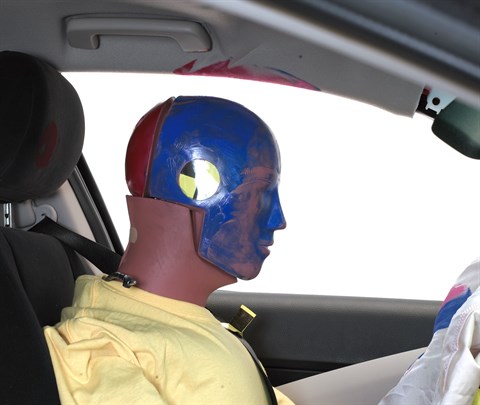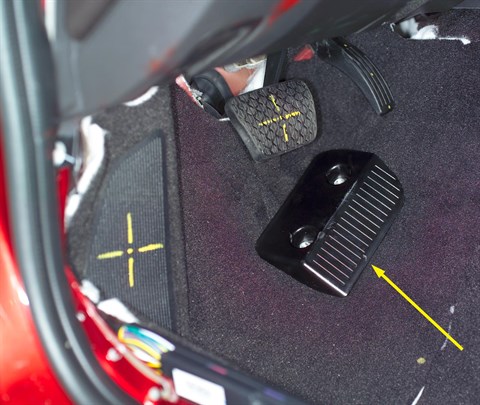Moderate overlap front: original test
Rating applies to 2006-07 models built after January 2006 and before February 2007
Tested vehicle: 2006 Ford Fusion SE 4-door
The Ford Fusion, Mercury Milan, and Lincoln Zephyr were introduced in the 2006 model year. The Zephyr was renamed the MKZ beginning with 2007 models.
All 2006-07 Fusion, Milan, and Zephyr/MKZ models manufactured after January 2006 include a hard plastic "ramp" bolted above or below the carpeting near the base of the accelerator pedal designed to decrease right leg and foot injury risk in frontal offset crashes (note: information about when a specific vehicle was manufactured is on the certification label typically affixed to the car on or near the driver door).
The Insurance Institute for Highway Safety has evaluated the crashworthiness of a Fusion with the added part in a 40 mph frontal offset crash test into a deformable barrier.
| Evaluation criteria | Rating |
|---|---|
| Overall evaluation | |
| Structure and safety cage | |
| Driver injury measures | |
| Head/neck | |
| Chest | |
| Leg/foot, left | |
| Leg/foot, right | |
| Driver restraints and dummy kinematics | |

Action shot taken during the frontal offset crash test.

The dummy's position in relation to the steering wheel and instrument panel after the crash test indicates that the driver's survival space was maintained well.

Smeared greasepaint indicates where the dummy's head hit the roof rail during rebound. Head acceleration from this hit was low.

Postcrash photo indicating the added "ramp" intended to reduce loading on the right leg and foot in frontal offset crashes. (Cars built later in 2006 have the ramp hidden underneath the carpeting; Ford says hiding it does not affect performance.)
Measures of occupant compartment intrusion on driver side
| Evaluation criteria | Measurement |
|---|---|
| Test ID | CEF0601 |
| Footwell intrusion | |
| Footrest (cm) | 9 |
| Left (cm) | 16 |
| Center (cm) | 15 |
| Right (cm) | 12 |
| Brake pedal (cm) | 6 |
| Instrument panel rearward movement | |
| Left (cm) | 3 |
| Right (cm) | 2 |
| Steering column movement | |
| Upward (cm) | 1 |
| Rearward (cm) | -3 |
| A-pillar rearward movement (cm) | 1 |
Driver injury measures
| Evaluation criteria | Measurement |
|---|---|
| Test ID | CEF0601 |
| Head | |
| HIC-15 | 307 |
| Peak gs at hard contact | 37 |
| Neck | |
| Tension (kN) | 1.6 |
| Extension bending moment (Nm) | 26 |
| Maximum Nij | 0.32 |
| Chest maximum compression (mm) | 35 |
| Legs | |
| Femur force - left (kN) | 2.3 |
| Femur force - right (kN) | 9.8 |
| Knee displacement - left (mm) | 0 |
| Knee displacement - right (mm) | 0 |
| Maximum tibia index - left | 0.46 |
| Maximum tibia index - right | 0.88 |
| Tibia axial force - left (kN) | 2.2 |
| Tibia axial force - right (kN) | 2.9 |
| Foot acceleration (g) | |
| Left | 130 |
| Right | 127 |
Side: original test
Rating applies to 2006 models
Tested vehicle: 2006 Ford Fusion SE 4-door without optional side airbags
The Ford Fusion and Mercury Milan were introduced in the 2006 model year.
| Evaluation criteria | Rating |
|---|---|
| Overall evaluation | |
| Structure and safety cage | |
| Driver injury measures | |
| Head/neck | |
| Torso | |
| Pelvis/leg | |
| Driver head protection The dummy's head was hit by the intruding barrier. This hit produced moderately high head injury measures, and head hits with intruding objects such as other vehicles, trees, and poles should be prevented. |
|
| Rear passenger injury measures | |
| Head/neck | |
| Torso | |
| Pelvis/leg | |
| Rear passenger head protection The dummy's head was hit by the pillar behind the rear passenger door. This pillar is required by federal standard to provide some protection for occupants' heads. |
|

View of the vehicle and barrier just after the crash test.

View of the vehicle after the crash with doors removed, showing the damage to the occupant compartment.

Action shot taken during the side impact crash test showing the driver dummy's head being hit by the intruding barrier.

Smeared greasepaint shows where the rear passenger dummy's head was hit by the pillar behind the rear passenger door.
Measures of occupant compartment intrusion on driver side
| Test ID | CES0534 |
|---|---|
| B-pillar to longitudinal centerline of driver's seat (cm) | -7.0 |
| Negative numbers indicate the amount by which the crush stopped short of the seat centerline. | |
Driver injury measures
| Evaluation criteria | Measurement |
|---|---|
| Test ID | CES0534 |
| Head HIC-15 | 649 |
| Neck | |
| Tension (kN) | 2.3 |
| Compression (kN) | 1.2 |
| Shoulder | |
| Lateral deflection (mm) | 53 |
| Lateral force (kN) | 2.8 |
| Torso | |
| Maximum deflection (mm) | 50 |
| Average deflection (mm) | 39 |
| Maximum deflection rate (m/s) | 7.54 |
| Maximum viscous criterion (m/s) | 1.67 |
| Pelvis | |
| Iliac force (kN) | 4.0 |
| Acetabulum force (kN) | 3.4 |
| Combined force (kN) | 7.4 |
| Left femur | |
| L-M force (kN) | 0.3 |
| L-M moment (Nm) | 64 |
| A-P moment (Nm) | 44 |
Passenger injury measures
| Evaluation criteria | Measurement |
|---|---|
| Test ID | CES0534 |
| Head HIC-15 | 242 |
| Neck | |
| Tension (kN) | 0.2 |
| Compression (kN) | 0.8 |
| Shoulder | |
| Lateral deflection (mm) | 38 |
| Lateral force (kN) | 1.9 |
| Torso | |
| Maximum deflection (mm) | 37 |
| Average deflection (mm) | 30 |
| Maximum deflection rate (m/s) | 3.70 |
| Maximum viscous criterion (m/s) | 0.66 |
| Pelvis | |
| Iliac force (kN) | 1.5 |
| Acetabulum force (kN) | 2.8 |
| Combined force (kN) | 3.9 |
| Left femur | |
| L-M force (kN) | 0.8 |
| L-M moment (Nm) | 125 |
| A-P moment (Nm) | 28 |
Roof strength
Rating applies to 2006-10 models built before May 2010
Tested vehicle: 2010 Ford Fusion SE 4-door
| Overall evaluation | |
|---|---|
| Curb weight | 3,394 lbs |
| Peak force | 11,300 lbs |
| Strength-to-weight ratio | 3.33 |
Head restraints & seats
Seat type: Manual-power cloth seats
| Overall evaluation | |
|---|---|
| Dynamic rating | |
| Seat/head restraint geometry |
| Seat type | Manual-power cloth seats |
|---|---|
| Geometry | |
| Backset (mm) | 82 |
| Distance below top of head (mm) | 58 |
| Seat design parameters | |
| Pass/fail | Fail |
| Max T1 acceleration (g) | 11.0 |
| Head contact time (ms) | 99 |
| Force rating | 2 |
| Neck forces | |
| Max neck shear force (N) | 203 |
| Max neck tension (N) | 671 |
About the head restraint & seat test
Currently, IIHS tests apply only to front seats.
